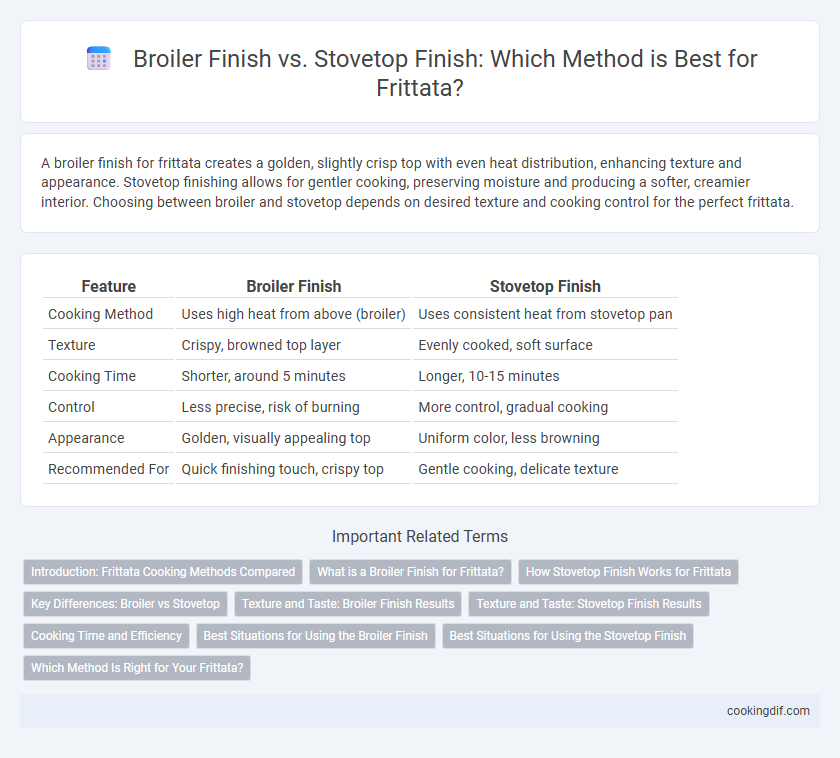A broiler finish for frittata creates a golden, slightly crisp top with even heat distribution, enhancing texture and appearance. Stovetop finishing allows for gentler cooking, preserving moisture and producing a softer, creamier interior. Choosing between broiler and stovetop depends on desired texture and cooking control for the perfect frittata.
Table of Comparison
| Feature | Broiler Finish | Stovetop Finish |
|---|---|---|
| Cooking Method | Uses high heat from above (broiler) | Uses consistent heat from stovetop pan |
| Texture | Crispy, browned top layer | Evenly cooked, soft surface |
| Cooking Time | Shorter, around 5 minutes | Longer, 10-15 minutes |
| Control | Less precise, risk of burning | More control, gradual cooking |
| Appearance | Golden, visually appealing top | Uniform color, less browning |
| Recommended For | Quick finishing touch, crispy top | Gentle cooking, delicate texture |
Introduction: Frittata Cooking Methods Compared
Broiler finish and stovetop finish are two popular methods for cooking frittatas, each impacting texture and flavor distinctly. Broiler finish creates a slightly browned, crisp top layer while maintaining a tender, airy interior, ideal for achieving a restaurant-quality appearance. Stovetop finish offers more control over cooking speed and temperature, producing a uniformly cooked, soft, and creamy frittata without browning.
What is a Broiler Finish for Frittata?
A broiler finish for frittata involves placing the partially cooked egg mixture under a broiler to quickly brown and set the top, creating a golden, slightly crisp surface. This method ensures even cooking and adds appealing texture without overcooking the eggs on the stovetop. Using a broiler finish is especially effective for thicker frittatas that require thorough cooking without flipping.
How Stovetop Finish Works for Frittata
Stovetop finish for frittata works by gently cooking the eggs on low heat, allowing the eggs to set slowly and evenly without browning too much, which preserves a tender texture throughout. Unlike broiler finish that uses intense direct heat to quickly brown and cook the top, stovetop finish relies on controlled heat distribution from the pan, giving more precise control over doneness. This method is especially effective for creating a creamy, custard-like interior while avoiding the potential dryness caused by broilers.
Key Differences: Broiler vs Stovetop
Broiler finish for frittatas delivers a crisp, golden top due to intense, direct heat, promoting even browning and a slightly caramelized texture. Stovetop finish relies on gentle heat and lids to steam the frittata, resulting in a softer, more uniform texture without the browned crust. Broiler method is faster and ideal for achieving a crispy surface, while stovetop offers controlled cooking to maintain moisture and tenderness.
Texture and Taste: Broiler Finish Results
Broiler finish on a frittata creates a golden, crisp top layer that contrasts with the creamy, tender interior, enhancing texture complexity. The intense heat caramelizes the surface, intensifying flavors and adding a slightly charred, smoky note that stovetop finishes often lack. This method boosts overall taste by providing a visually appealing, flavorful crust without overcooking the delicate eggs beneath.
Texture and Taste: Stovetop Finish Results
Stovetop finish for frittatas yields a creamy, tender texture with a slightly custardy interior that highlights the freshness of eggs and ingredients. This method enhances flavor depth by gently cooking without over-browning, preserving delicate, savory notes. Compared to the firmer, browned crust from broiler finishing, stovetop results offer a softer bite and subtler taste profile favored by those seeking a smoother, less caramelized frittata experience.
Cooking Time and Efficiency
Broiler finish in frittata cooking significantly reduces overall time by quickly setting the top layer, typically taking 2-4 minutes, compared to stovetop finishing, which requires gentle heat and around 10-15 minutes to cook through. Broiler finishing enhances efficiency by providing even browning and a firm texture without extended monitoring, whereas stovetop methods demand constant attention to avoid burning and uneven cooking. Choosing broiler finish optimizes cooking speed and energy use, making it ideal for quick preparation and consistent results.
Best Situations for Using the Broiler Finish
The broiler finish for frittatas is ideal when a quick, even browning is desired on the top layer without further cooking the entire dish, preserving a soft, custardy texture inside. Situations such as preparing a large frittata that requires minimal stovetop time or when a crisp, golden crust adds a visually appealing contrast benefit most from broiler finishing. This method is especially effective for achieving restaurant-quality presentation and texture in recipes incorporating cheese or delicate vegetables.
Best Situations for Using the Stovetop Finish
The stovetop finish for frittatas is ideal when precise control over cooking temperature is needed to avoid overcooking or browning. It works best for smaller portions or when a custard-like texture is desired, allowing gentle, even heat to set the eggs without a broiler's intense direct heat. This method is particularly suitable for kitchens lacking a broiler or when a softer, creamier interior and less charred top are preferred.
Which Method Is Right for Your Frittata?
Choosing between broiler finish and stovetop finish for your frittata depends on texture preference and cooking convenience. A broiler finish creates a golden, slightly crispy top, ideal for more structured and visually appealing frittatas, while stovetop finishing results in a softer, creamier surface suitable for a more tender bite. Consider broiler finish for quick, even browning and stovetop finish for gentle, controlled cooking to match your desired frittata style.
Broiler finish vs stovetop finish for Frittata Infographic

 cookingdif.com
cookingdif.com